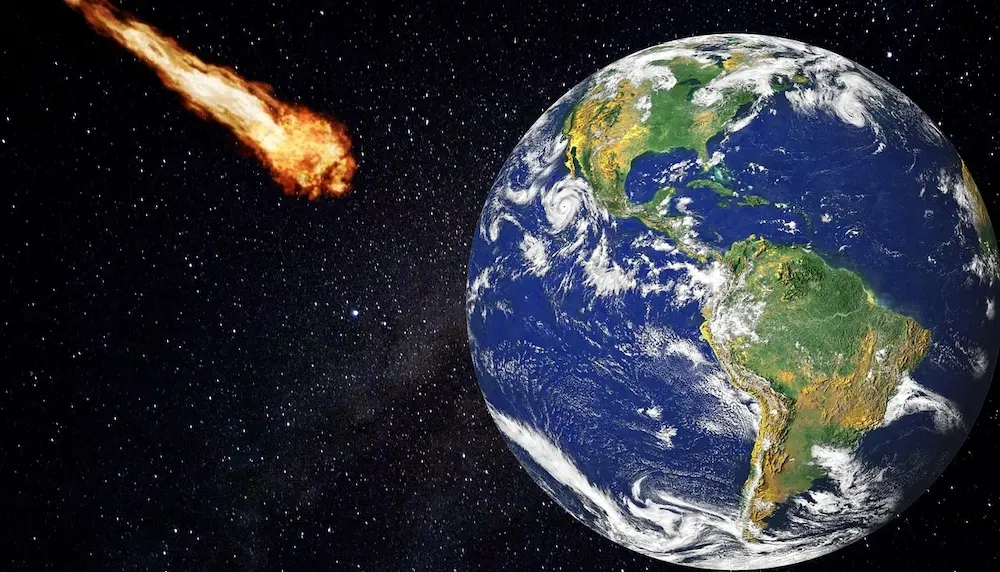
Asteroid 2025 FA22, taller than Qutub Minar, will safely pass Earth at 24,000 mph (photo-pixabay)
A Giant Visitor from Space: What Is Asteroid 2025 FA22?
Giant Asteroid FA22 to Zoom Past Earth at 24,000 mph- Imagine something taller than Delhi’s Qutub Minar now picture it flying through space at 24,000 miles per hour. That’s asteroid 2025 FA22, a massive space rock discovered earlier this year by the Pan-STARRS 2 telescope in Hawaii. It’s estimated to be between 120 and 280 meters wide. For comparison, the Qutub Minar stands at 73 meters. Even at its smallest size, FA22 is nearly twice as tall and at its largest, it’s almost four times taller.
This asteroid belongs to a group called “Aten asteroids,” which orbit close to Earth and sometimes cross our planet’s path. FA22 completes one orbit around the Sun every 1.85 years, following a slightly tilted and stretched path. On September 18, 2025, it will make its closest approach to Earth, passing at a distance of about 842,000 kilometres just over twice the distance between Earth and the Moon.
While that may sound far, in space terms, it’s considered a close encounter. That’s why NASA and other space agencies are watching FA22 very carefully.
Should We Be Worried? Understanding the Risk
The short answer is: no, we don’t need to panic. NASA has confirmed that asteroid FA22 poses no threat to Earth during this flyby. It’s being tracked by the Center for Near-Earth Object Studies (CNEOS) and the Jet Propulsion Laboratory (JPL), and its path has been mapped with great precision.
Here’s why scientists are still paying close attention:
- Potentially Hazardous Label: FA22 is big enough and close enough to be labeled “potentially hazardous.” NASA uses this term for any asteroid larger than 85 meters that comes within 7.4 million kilometers of Earth. FA22 fits that definition, but it’s not on a collision course.
- Past Predictions: When FA22 was first discovered, there was a tiny chance it could hit Earth in 2089. It even topped the European Space Agency’s risk list for a short time. But after more observations, scientists ruled out any danger. It’s now considered safe for the foreseeable future.
- Why Track It Anyway? Even though FA22 won’t hit us, its size and speed make it an important object to study. Small changes in its orbit—caused by gravity or sunlight—could affect its path over decades. By watching it closely now, scientists can improve future predictions and prepare for other asteroids that might pose real threats.
What Makes FA22 So Special?
Asteroids like FA22 don’t come by every day. In fact, space rocks of this size and proximity only pass Earth once or twice a decade. That makes FA22 a rare and valuable opportunity for scientists and skywatchers alike.
Here’s what makes it stand out:
- Size and Speed: At up to 280 meters wide and traveling at 24,127 mph, FA22 is a cosmic powerhouse. If it were to hit Earth (which it won’t), it could wipe out a major city. That’s why its safe flyby is both a relief and a reminder.
- Scientific Goldmine: During its flyby, researchers will use radar and telescopes to study FA22’s shape, surface, and movement. These observations help scientists understand how asteroids behave and how to protect Earth from future threats.
- Public Interest: FA22 has captured attention worldwide—not just for its size, but for its dramatic comparison to landmarks like the Qutub Minar. It’s also a great moment for amateur astronomers. With a good telescope or binoculars, some people may be able to spot it in the night sky.
- India’s Role: The Indian Space Research Organisation (ISRO) is also stepping up its asteroid research. Future plans include working with NASA and other agencies to study and even land on asteroids. FA22’s flyby is a chance for India to test its tracking systems and deepen its space science capabilities.
Lessons from the Flyby: Why Asteroids Matter to Us All
Asteroid 2025 FA22 may be harmless, but it’s a powerful reminder of how fragile our planet is. Space is full of surprises, and even small changes in an asteroid’s path can lead to big consequences over time.
Here are some key takeaways:
- Planetary Defense Is Real: NASA and other agencies have programs to detect and track near-Earth objects. Events like FA22’s flyby help improve these systems and prepare for future threats.
- Science Needs Support: Studying asteroids isn’t just about curiosity—it’s about safety. The more we learn, the better we can protect Earth. That’s why funding and public interest in space science are so important.
- Public Awareness Matters: When people hear about asteroids like FA22, they often ask, “Should we be worried?” That question opens the door to learning about space, science, and how we can work together to stay safe.
- A Moment to Look Up: In a world full of noise and stress, events like FA22’s flyby invite us to pause and look at the sky. They remind us that we’re part of a vast universe—and that even giant space rocks can pass us by without harm.
Asteroid 2025 FA22 won’t hit Earth, but it’s giving us a cosmic wake-up call. It’s a chance to learn, prepare, and marvel at the wonders of space. So on September 18, step outside, look up, and remember: the universe is watching us, just as we’re watching it.
Also read:
Stay informed with the latest news and updates – only on Rapido Updates.